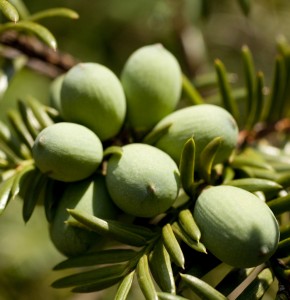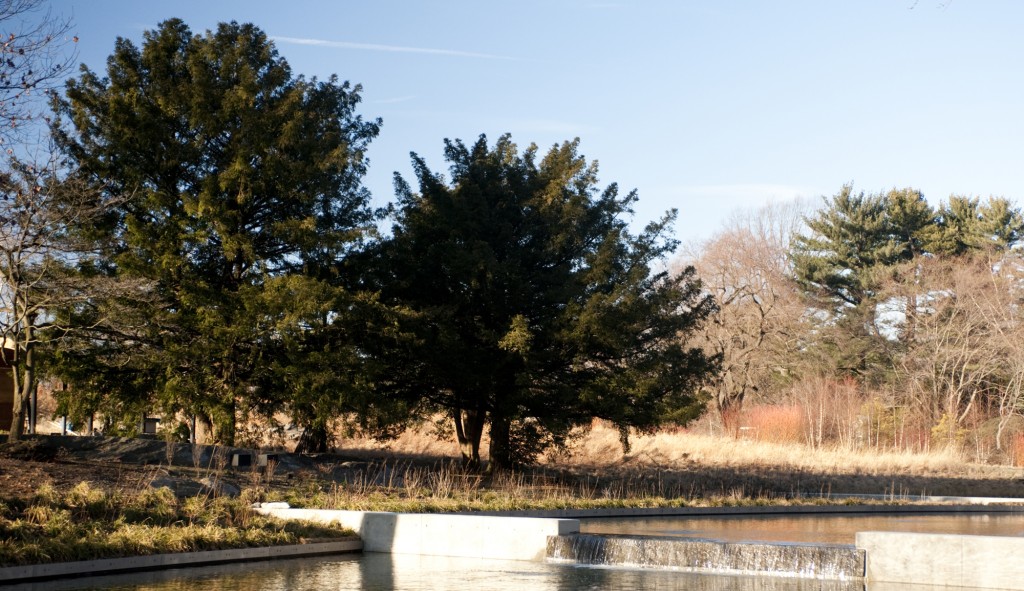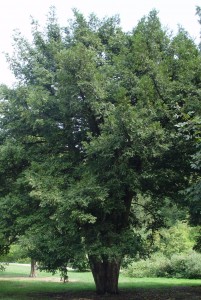The Torreya Tree: Foreign Territory
Posted in Gardens and Collections on March 27 2013, by Matt Newman
After months of dedicated effort, the NYBG‘s Native Plant Garden is scheduled for a grand reopening in May of 2013. Until then, we’ll occasionally touch on the plants, landscapes, and landmark features that have gone into this classic space. Visit the official page for more information.
 With the Native Plant Garden opening in May, it seemed only right to highlight some of the plants and trees that have gone into its reimagining. I kicked things off a while back with the Spiranthes orchids growing here and there about the space. This time around, I thought I’d go in a different direction–and highlight the only non-natives to be found in the Native Plant Garden. Stately and full with spiraled needles, the decades-old Torreya trees near the center of the garden are the only explicit outsiders to have kept their citizenship during the landscape’s sweeping revision. But before you throw your arms up in a huff of indignation, hear me out!
With the Native Plant Garden opening in May, it seemed only right to highlight some of the plants and trees that have gone into its reimagining. I kicked things off a while back with the Spiranthes orchids growing here and there about the space. This time around, I thought I’d go in a different direction–and highlight the only non-natives to be found in the Native Plant Garden. Stately and full with spiraled needles, the decades-old Torreya trees near the center of the garden are the only explicit outsiders to have kept their citizenship during the landscape’s sweeping revision. But before you throw your arms up in a huff of indignation, hear me out!
When Oehme von Sweden first envisioned the new Native Plant Garden’s layout, the Torreyas–Japanese natives, originally–were some of the more notable residents popping up in discussions. They stood three abreast, dense and squat, their thick evergreen needles shadowing what the designers pegged as the center of the new landscape. The broad path of the water feature would brush right past them on its way through the middle of the garden, so it’s not as though these conifers were inconspicuous. And that left a question: what would people think, seeing foreign growth in a native sanctuary?
Looking at that question now, it seems less significant. The Native Plant Garden is designed as a showcase, not only of the plants found growing wild in the New York region, but of the ways in which home gardeners can create their own stunning native displays. And design, as in so many cases, is only so good as the additions and subtractions that make up the landscape. Standing as they have for over a century now, it was decided that the Torreya trees would remain as is.

Torreya nucifera, also known as the kaya or Japanese nutmeg, is an evergreen with a slow-growing habit–not unlike the yew trees in the Taxus genus. The seeds are edible and have been known to make a decent vegetable oil. Culinarily speaking, it’s all very workaday. But the prized wood fetches far more interest. Kaya timber is famed for its historic use in Go boards, where the rich golden color mingles with an acoustic je ne sais quois best demonstrated by a Go stone snapping against the surface. Over the years, the sheer demand has taken its toll on wild populations; Torreyas in Japan are now so scarce that the government has had to protect them from cutting. In turn, laws now require that a Torreya must die of natural causes before it can be used, leading, as you can probably guess, to exorbitant prices on the open market.
Of course, we’re not leaving the Torreyas where they are for the sake of their value as a resource. These particular trees, first officially accessioned in 1951, have been a sight on Garden grounds since the 19th century–planted by The New York Botanical Garden’s founders as part of the original pinetum. The history, not to mention the sheer success of these trees in that time, is too much to write off with native plant pedantry.
 “Our thought has been that these trees will be a good opportunity to discuss disjunct taxa,” says Native Plant Garden Director Jody Payne, “as the Torreyas come from very limited ranges in Asia, with other species in California and Florida. As the Torreyas sit in the garden, they offer a veiled view around the meadow and beneath the trees to the water feature. I think they add something special to the design with their presence and position.”
“Our thought has been that these trees will be a good opportunity to discuss disjunct taxa,” says Native Plant Garden Director Jody Payne, “as the Torreyas come from very limited ranges in Asia, with other species in California and Florida. As the Torreyas sit in the garden, they offer a veiled view around the meadow and beneath the trees to the water feature. I think they add something special to the design with their presence and position.”
If you’re stumped over the mention of “disjunct taxa,” it refers to biologically related groups growing natively in disparate locations–North America and Asia, for example. Torreya nucifera is one of only a few species in the genus, and its rarity in the wild–specifically southern Japan and a single island off the coast of South Korea–mirrors that of its American relatives; T. taxifolia grows only in northern Florida, while T. californica now grows in a narrow range within its namesake state. The fossil record, however, points to current populations as remnants of what was once a much wider-ranging genus, with Florida’s taxifolia species at one time settling an area as far up the coast as North Carolina.
The erstwhile range of this disjunct genus provides a significant historic connection to eastern North America, but it’s not the sole tie. The Torreya genus is further named for a true New York City local by the name of John Torrey, mentor of renowned scientist Asa Gray and official botanist to the State of New York through much of the 19th century. In this light, it’s not all that difficult to think of the Garden’s Japanese Torreyas as (long-term) visiting relatives.
Once you’ve seen the Torreyas in person, residents of the Garden since its earliest days, we think you’ll “get it.” They’re not only thriving, elegant, and mature trees worthy of preservation, but a sort of lynchpin around which much of the new aesthetic grows. Better yet, they create a living link to the rich history of this landscape. Over the years, they have come to earn our native love, if not the official stamp of native origin, and something tells me turning the trees into game boards simply wouldn’t do these classics justice.

